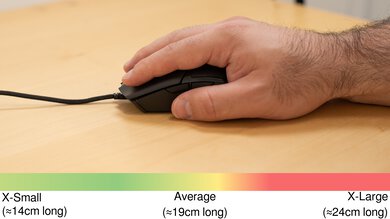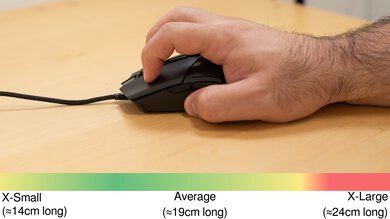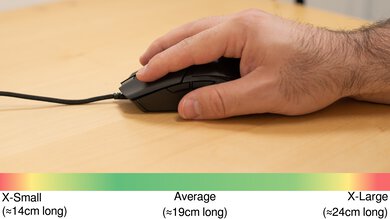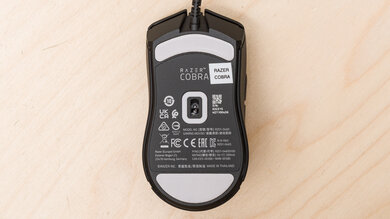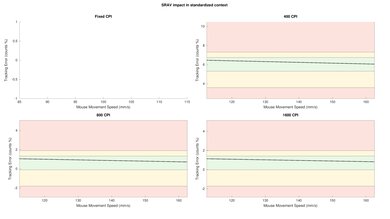The Razer Cobra is a lightweight wired gaming mouse with a low-profile, symmetrical shape. It has two side buttons on the left and RGB lighting in the palm rest and around the back end, which casts an underglow effect on your mousepad or desk. Using this mouse's companion software, You can customize this RGB lighting and make changes to various sensor and profile settings.
Our Verdict
The Razer Cobra is acceptable for work but isn't designed specifically for this use. Overall, it has good build quality and a comfortable symmetrical shape best suited for small or medium-sized hands. You can also reprogram all of the buttons on this mouse using the companion software. Unfortunately, its scroll wheel lacks productivity features like a free-scrolling mode or left and right tilt inputs.
-
Good build quality overall.
-
Minor body flex on the side panels and palm rest.
-
Scroll wheel lacks a free-scrolling mode and left/right tilt inputs.
The Razer Cobra is an excellent FPS gaming mouse. This mouse has remarkably low latency and excellent overall sensor performance, delivering a very snappy and responsive feeling in-game experience. It's also very lightweight and has good build quality overall. Its mouse feet glide smoothly across mousepads and desks, and it has a fairly lightweight and flexible cable. That said, there's some minor flexibility in some areas of the plastic body. However, this is unlikely to be an issue when holding the mouse normally.
-
Good build quality overall.
-
Excellent sensor performance.
-
Outstanding click latency.
-
Minor body flex on the side panels and palm rest.
-
Cable not quite as lightweight and flexible as on some recent Razer releases.
The Razer Cobra is good for MMO gaming but doesn't have nearly as many side buttons as a dedicated MMO gaming mouse. That said, you can reprogram all its buttons using the companion software. Overall, this mouse has good build quality, but the plastic side panels exhibit a bit of flexibility in some places. It also has remarkably low latency and excellent overall sensor performance—delivering an extremely responsive-feeling gaming experience.
-
Good build quality overall.
-
Excellent sensor performance.
-
Outstanding click latency.
-
Minor body flex on the side panels and palm rest.
-
Cable not quite as lightweight and flexible as on some recent Razer releases.
-
Has fewer programable buttons than a dedicated MMO gaming mouse.
The Razer Cobra wired mouse has remarkably good raw performance. Its click latency is extremely low, and its sensor provides remarkable motion latency and excellent accuracy performance that closely translates the physical movements you make with your mouse into the cursor movements you see on screen.
-
Outstanding click latency.
-
Superb sensor latency.
-
Impressive sensor accuracy.
- 6.2 Work
- 8.9 Video Games (FPS)
- 7.9 Video Games (MMO)
- 9.2 Raw Performance
Changelog
- Updated Jan 05, 2024: We've updated the CPI graph displayed in the Sensor Latency section of this review. Our results remain the same, but these graphs have two new columns with results from the Delay At Half Movement and Delay To End Of Movement tests.
- Updated Oct 02, 2023: We've added text to this review for the new tests added in TBU 1.5.
- Updated Oct 02, 2023: We've converted this review to Test Bench 1.5. This update adds a new Main Button test group, which provides button actuation data and switch information. We've also made minor changes to how we calculate the Office usage score. For more details, you can see our full changelog here.
- Updated Aug 16, 2023: Review published.
- Updated Aug 08, 2023: Early access published.
Check Price
Differences Between Sizes And Variants
The Razer Cobra wired mouse is only available in a black color option. There aren't other variants at the time of writing, but there is a wireless version of this mouse with a more advanced sensor and more extensive and customizable RGB lighting called the Razer Cobra Pro.
We can see the label of the Razer Cobra we bought and tested here.
Compared To Other Mice
The Razer Cobra wired mouse is a lightweight gaming model with the same low-profile, symmetrical shape, and overall design philosophy as the older Razer Viper Mini. This new mouse introduces customizable RGB lighting, more durable optical switches, and a slightly improved sensor with a lower lift-off distance than the previous generation Razer Viper Mini.
Compared directly to its wireless version, the Razer Cobra Pro, the wired-only Razer Cobra doesn't use Razer's newest sensor or have as many customizable RGB zones. That said, it offers remarkably high-end gaming performance considering its budget price point, and it's a compelling option if you prioritize lower-weight options and don't mind or even prefer wired-only mice.
For more recommendations, see our picks for the best wired mouse, the best gaming mouse, and the best mouse.
The Razer Viper Mini and the Razer Cobra are gaming mice with virtually the same size and shape. The Cobra has a slightly better sensor with a lower lift-off distance. On the other hand, the Viper Mini feels somewhat sturdier.
The Razer Cobra Pro and the Razer Cobra are mice in the same lineup and are the same size and shape. The Pro is a wireless model with better overall sensor performance, better build quality, and more customizable RGB lighting zones. It also has rubberized side grips, which the Cobra lacks. On the other hand, the Cobra is a wired-only model that's significantly more lightweight.
The Razer Cobra and the Razer Viper 8KHz have the same symmetrical shape, but the Cobra is smaller. The Cobra is lighter and has RGB lighting, which the Viper lacks. On the other hand, the Viper 8KHz has a slightly more lightweight and flexible cable, better sensor accuracy, and it supports a higher maximum polling rate of 8000Hz.
The HyperX Pulsefire Haste 2 and the Razer Cobra are wired gaming mice. The HyperX is larger, slightly lighter, and feels a bit sturdier. It also has better sensor accuracy and a bit more flexible cable. On the other hand, the Razer has significantly better click latency and more extensive RGB lighting.
Test Results
This mouse has a textured, matte black plastic body with glossy plastic accents. This mouse looks similar to its more premium wireless counterpart, the Razer Cobra Pro. However, unlike the wireless version with rubberized side grips, this mouse has plastic sides. This mouse also has fewer RGB lighting zones, with a single zone in the Razer brand emblem on the palm rest and another around the back rim of the mouse, producing a faint underglow effect on your mousepad or desk. Note that while you can customize the RGB using the companion software, the two lighting zones act as a single customizable lighting element and can't be controlled independently.
This mouse shares virtually the same dimensions as the original Razer Viper Mini and exactly the same dimensions as the more premium wireless version of this mouse, the Razer Cobra Pro. However, this mouse doesn't have rubberized side grips, unlike the Razer Cobra Pro.
This mouse has good build quality overall. Its body is made of solid plastic, which doesn't feel cheap, and has a slightly more textured feel compared to the smoother finish of the more premium wireless version of this mouse, the Razer Cobra Pro. Unlike the wireless version, this mouse doesn't have rubberized sides.
There are no loose or wobbling parts, and the left- and right-click buttons have minimal side-to-side travel. Overall, the plastic surfaces feel sturdy. However, there's slight flex in the body, specifically on the underside, on both side panels, and the corner of the palm panel just above the rearmost side button.
If you apply deliberate pressure to the plastic surface near the back side button or the CPI button on the top of the mouse, You can unintentionally activate these buttons. However, doing so requires deliberate localized pressure and is unlikely to be an issue when holding and using the mouse normally.
This mouse has a low-profile, symmetrical shape with two side buttons on the left. The dimensions of this mouse are virtually identical to those of the older Razer Viper Mini. Much like the Viper Mini, this mouse is best suited for small or medium-sized hands and ideal for a fingertip grip.
The shape and size of this mouse also make it suitable for a claw or, to a lesser degree, a palm grip for smaller hands.
This is a wired-only mouse that can't be used wirelessly. This mouse has a separate wireless version called the Razer Cobra Pro.
This mouse has what Razer calls a 'Speedflex' cable. It's a non-detachable cable that feels durable and is fairly lightweight and flexible.
However, this cable is noticeably stiffer and retains slightly more kinks from its packaging compared to the 'Speedflex' branded charging cables included with other recent Razer releases, including the Razer Viper V2 Pro, the Razer DeathAdder V3 Pro, and the Razer Basilisk V3 Pro.
This mouse's left- and right-click buttons use Razer Optical Mouse Switch Gen 3 switches.
You can reprogram all of the buttons on this mouse, including the left- and right-click buttons. However, one button must always be set as the primary click button. You can also assign a 'Hypershift' button to toggle to a secondary layer of programmable inputs.
This mouse has exceptionally low click latency. It delivers a highly responsive-feeling experience for gaming in any genre and is well-suited for casual or competitive play.
This mouse provides excellent CPI performance. The sensor has impressive tracking accuracy and relatively little variation at different speeds and CPI settings, so the physical movements you make with your mouse translate closely to those you see on-screen.
This mouse provides superb sensor latency performance. The sensor reacts extremely quickly when you move your mouse, and these movements very closely correspond to the timing of the cursor movements you see on-screen.
The available polling rate settings are 125Hz, 500Hz, and 1000Hz. You can adjust various sensor settings using the companion software, including polling rate, CPI, and lift-off distance.
This mouse has a rubberized scroll wheel with small bumps for added grip. Scrolling feels precise, and the scroll button has satisfying tactility and doesn't take too much force to activate.
Each scroll step is well-defined, and scrolling is very quiet. The scrolling noise is significantly quieter compared to the wireless Razer Cobra Pro, but the individual scrolling steps don't feel as pronounced.
The noise made by the left- and right mouse clicks, all buttons, and the scroll wheel are all fairly quiet.
This mouse uses Razer's Synapse 3 software, which is well laid out and relatively easy to navigate. This software allows you to customize expected options, including RGB lighting, CPI, button programming, polling rate, and lift-off distance. The only settings you can save to onboard memory are CPI and polling rate settings. This means you'll need to have the software open and running in the background to enable other options, like custom RGB lighting or reprogrammed button layouts.
Like similar software options from other major manufacturers, this software is a source of criticism from the broader community. While we didn't experience any issues during the testing of this mouse, many users online criticize this software for requiring frequent updates and taking up disproportionate system resources, among other complaints. This software may be frustrating if you prefer more lightweight software options or no software at all.
Comments
Razer Cobra: Main Discussion
Let us know why you want us to review the product here, or encourage others to vote for this product.
This product has been merged with Razer Cobra Wired Gaming Mouse: 58g Lightweight - G. Follow the discussion here.
- 43230
Just bought this mouse, and it has the LOUDEST left and right clicks I’ve ever heard in my life, and I’ve used a lot of different mice :( If you say these clicks are “fairly quiet” than I can’t even imagine what is loud for you…
Hi Noviot1977, We appreciate the feedback.
Our current Noise test definitely has some limitations. We’ve been discussing the possibility that we’ll expand the test to add a measurement in A-weighted decibels in the future, similar to recent changes we’ve made to our Typing Noise test for keyboard reviews.
In any case, while the left- and right-click buttons on the Razer Cobra aren’t whisper quiet compared to many productivity mice with silent switches, our testing found they’re quiet in relation to all the mice we’ve tested and they produce similar noise compared to most gaming mice, especially those with optical switches, which are often (but not always) slightly louder.
That said, as you’ve pointed out, your experience will heavily depend on your frame of reference. If you’d like to share, we’d love to hear what mice you’ve used in the past. It can help us understand where you’re coming from, and it may be helpful to others coming into this review.
Once again, thanks for reaching out to us. Best wishes!
- 21010
Just bought this mouse, and it has the LOUDEST left and right clicks I’ve ever heard in my life, and I’ve used a lot of different mice :( If you say these clicks are “fairly quiet” than I can’t even imagine what is loud for you…
Update: We’ve updated the CPI graph displayed in the Sensor Latency section of this review. Our results remain the same, but these graphs have two new columns with results from the Delay At Half Movement and Delay To End Of Movement tests.







